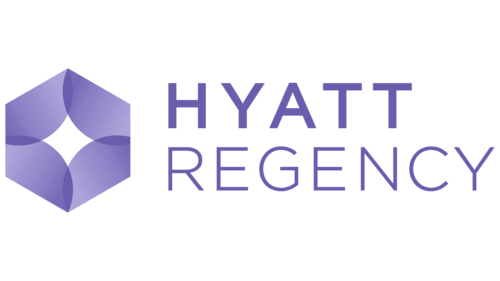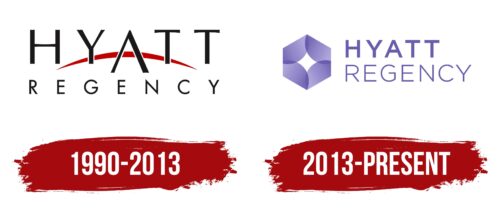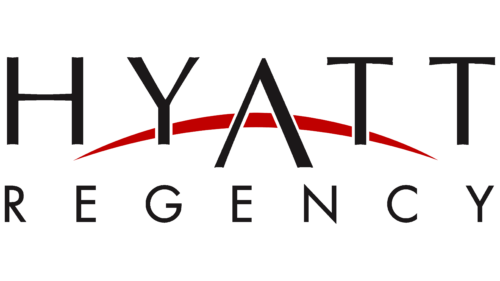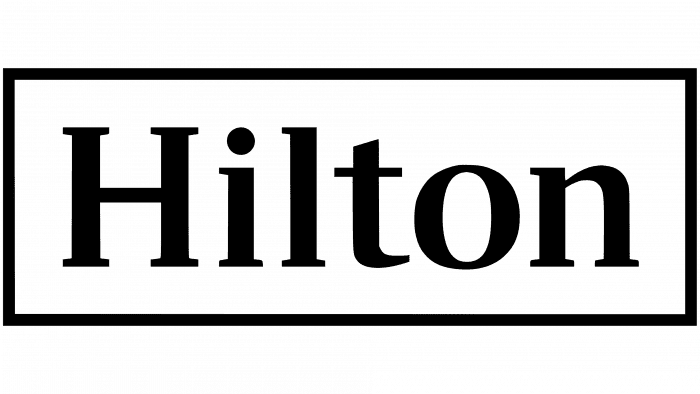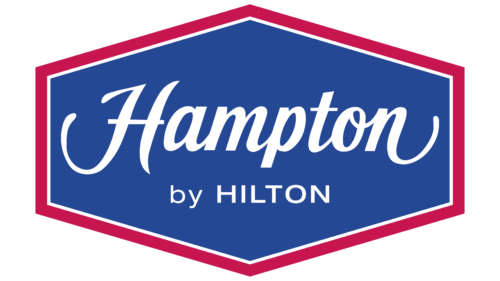The Hyatt Regency logo combines multiple styles and motifs, forming a complex graphic composition as an original and worthy emblem. The main goal of this identity is to enhance the recognition and popularity of the hotel chain, which is known for its commitment to maximum comfort and first-class service. The unique visual symbol includes various elements, harmoniously blending different meaningful parts. It comprises several text blocks and an image, emphasizing the company’s individuality and reliability.
A minimalist approach is closely intertwined with a classic style, creating a special sense of unity. Elements of modern trends from different periods are also evident. The graphic components enhance the visual advantages of the identity, adding extra expressiveness. This iconic logo reflects the company’s uniqueness and commitment to high standards, making it an important part of its identity.
Hyatt Regency: Brand overview
The Hyatt Regency story began in 1957 when businessmen Jay Pritzker and his brother Donald purchased the Hyatt House, a small hotel near Los Angeles Airport. This modest 13-room motel marked the beginning of what would grow into one of the largest hotel chains in the world. The Pritzker brothers saw an opportunity for high-quality accommodations for tourists and business travelers in the growing market.
A key moment in the company’s history came in 1967 with the opening of the first Hyatt Regency hotel in Atlanta. This hotel was a game-changer for the industry, featuring a striking 21-story atrium designed by John Portman. The innovative design emphasized openness and grandeur, becoming a hallmark of the company for years. This architectural breakthrough attracted both guests and industry professionals. Throughout the next decade, the hotel group expanded rapidly across major U.S. cities, consistently introducing cutting-edge designs and emphasizing continuous improvement. The Chicago location, which opened in 1973, became one of the largest convention hotels in the world.
In the 1980s, the company began expanding internationally. The brand opened its first overseas hotel in Macau in 1980, followed by properties in the Middle East, Asia, and Europe. Each new location adapted the hotel concept to local cultures and architectural styles, allowing the company to thrive in diverse markets.
However, its history has not been without challenges. In 1981, the collapse of the overhead walkways at the Kansas City location resulted in many fatalities. This tragic event led to significant safety reviews across the company and the broader U.S. construction industry.
In the 1990s, the chain continued to innovate and grow. Iconic hotels opened in cities like Sydney, Tokyo, and Paris, and the brand focused on expanding business services and conference facilities to meet the increasing demand for corporate events.
The early 2000s brought new challenges as the global economy shifted and competition in the hotel industry intensified. In response, the company updated and modernized its properties, adding new amenities, redesigning interiors, and incorporating advanced technologies to stay competitive and meet modern travelers’ expectations.
The 2010s marked a period of digital transformation. The company invested heavily in online booking platforms, loyalty programs, and mobile apps to enhance the guest experience and streamline operations. Personalizing guest services became a major focus of the brand’s strategy during this time.
By 2020, the hotel group had solidified its position as a leader in the upscale, full-service hotel market. The brand continued to open new hotels in prime locations worldwide, combining local elements in both design and service with the high standards expected of a global chain.
Despite global challenges in the early 2020s, the hotel group adapted to the evolving needs of travelers. The company introduced new safety and hygiene protocols, developed flexible workspaces and accommodation options, and strengthened its presence in resort destinations to meet the rising demand for relaxation and recovery-focused experiences.
By 2023, the company had grown into a global hotel network with over 200 locations in multiple countries. The brand has continued to evolve while staying true to its core values of innovative design, outstanding customer service, and a commitment to delivering unique experiences for every guest. The journey from a small motel to a global hotel chain reflects how vision, innovation, and adaptability can lead to long-term success in the ever-changing hospitality industry.
Meaning and History
What is Hyatt Regency?
This is a well-known luxury hotel brand renowned for its blend of amenities for both business and leisure travelers. The hotels are typically located in key business districts, bustling cities, and popular resort destinations worldwide. Guests are offered spacious rooms, modern fitness centers, restaurants catering to all tastes, and large conference rooms for business events. A notable feature of the brand is the unique lobby designs with atriums, creating bright, open spaces for socializing and relaxation. Each hotel often reflects the architectural or cultural motifs of the region while maintaining the brand’s high standards for comfort and service quality.
1990 – 2013
The original logo featured three key elements. The brand name was conventionally divided into two parts, visually expressed by placing the words in two rows rather than on a single horizontal line. This decision added a sense of scale and solidity, making the perception of the brand weightier. This approach helped create an impression of stability and foundation, which was especially important for strengthening the brand’s image.
The white background of the logo made the text more noticeable, while the bright red semicircle served as a focal point, drawing the viewer’s attention. The visual symbol appeared as a complex composition, where each element was part of a unified whole, allowing the audience to appreciate the scope of the company’s operations. Each year, the brand offered its guests more comfortable places to stay, which was reflected in the evolution of the logo. The classic tone highlighted the company’s focus on progress and its pursuit of excellence. The uniform letters, including the superscript, shaped the brand’s perception as a symbol of reliability and stability in all aspects.
A distinctive identity element was the sun, rendered in an unconventional form. It appeared as a semicircle, with a slightly rough outline, or possibly a crescent moon. The image, placed behind the text, could be interpreted differently, adding a layer of symbolism to the emblem. However, according to the designers’ vision, this red element represented the sun—a symbol of nature’s energy. In this context, it embodied Hyatt Regency’s forward-looking ambition, with the company seeing its brightness and success as an essential part of its journey ahead.
2013 – today
The modern Hyatt Regency logo differs from its predecessor. It feels like a new chapter in a popular series, reflecting new ideas and directions. A geometric shape on the right side of the text draws particular attention. Although it is not at the center of the composition, its role in the emblem is just as important. The hexagon, rendered in a gradient of purple shades, is the central element, creating a sense of scale and depth. This symbol is familiar to anyone who has visited the company’s hotels, as it recalls the well-known design of the brand’s halls, acting as an important identifier.
The purple color palette is also applied to the company’s name. The two words are presented in different shades, creating a sense of their separate existence. However, the multidimensionality of the color brings the two together, forming a cohesive perception. This design choice makes the logo more expressive and dynamic.
Often, logos consist of two words, and both elements are the same color and font. However, this visual sign breaks that mold. “Hyatt Regency” is divided into two parts with a clear contrast. The word “Hyatt” is displayed in bold font, giving it weight and importance, while “Regency” is shown in a thinner font. Both words are presented in large capital letters, emphasizing the status and authority of this international company. This graphic approach reinforces the brand’s reliability and strength.
